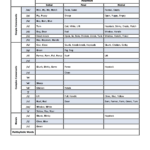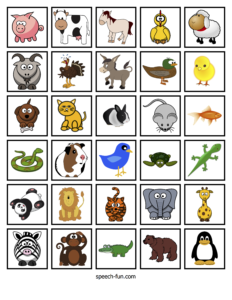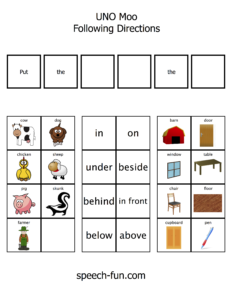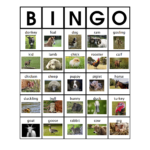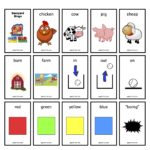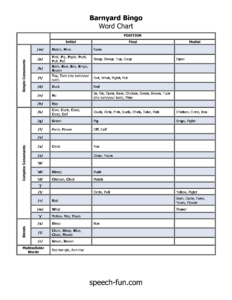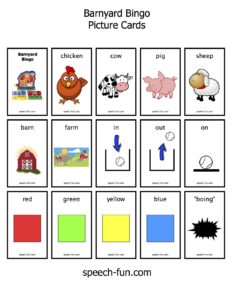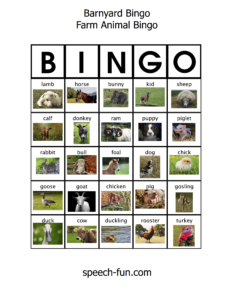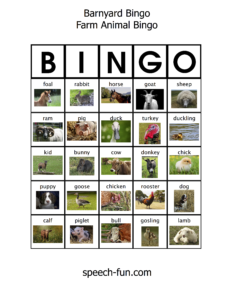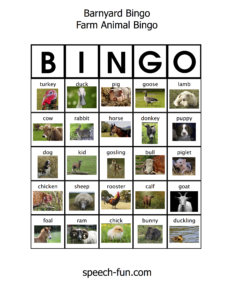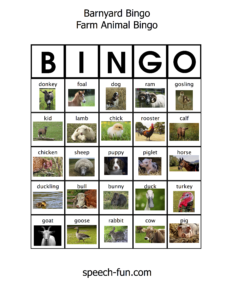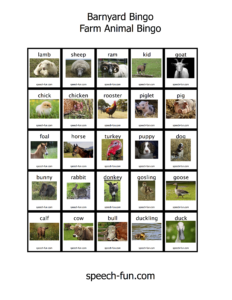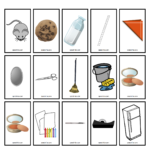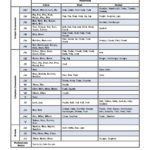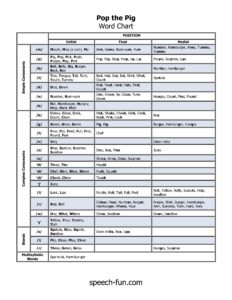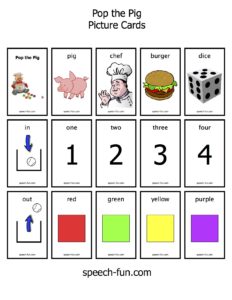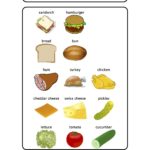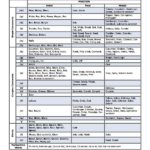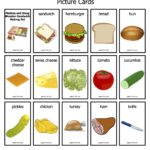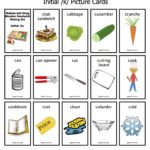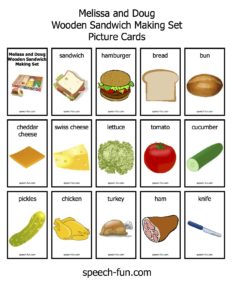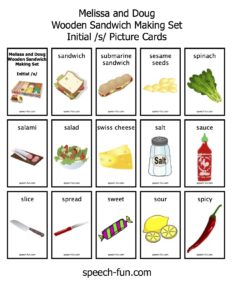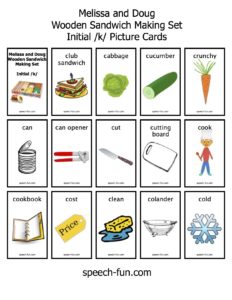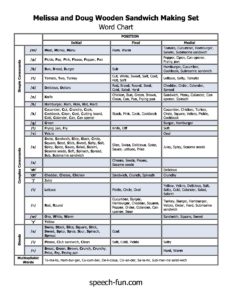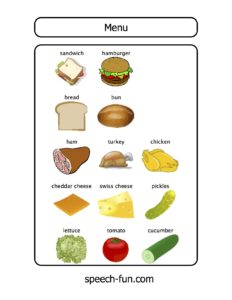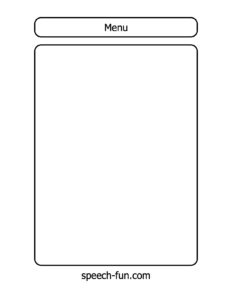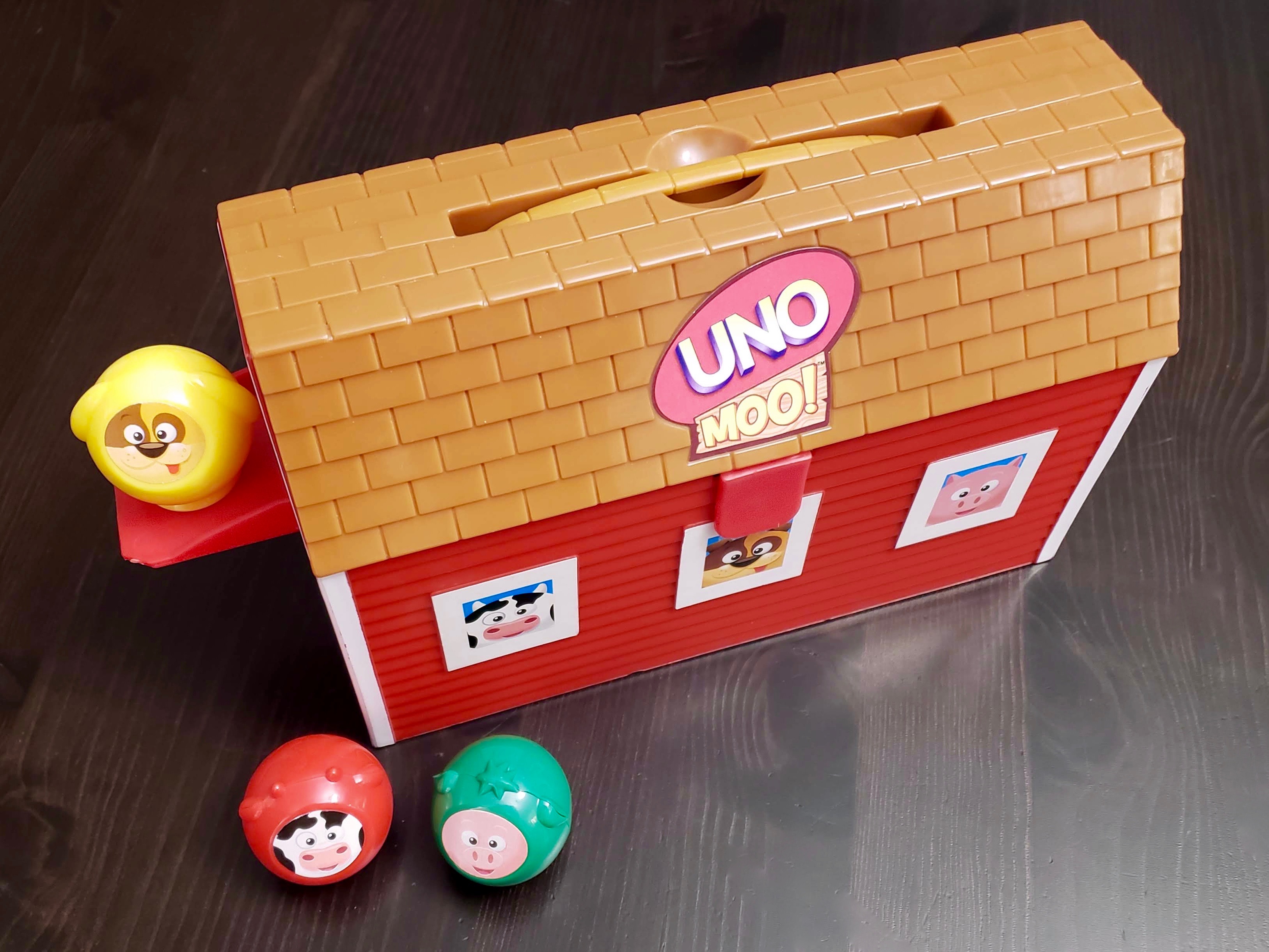
Updated on September 21, 2018
UNO Moo
UNO Moo is a game that has been in my collection for a number of years. This is another high-quality, very durable game. UNO Moo contains a barn, 28 animals and farmers, and 4 fences. Besides the durability of this game, I love the flexibility. While at times I play UNO Moo following the rules, I often alter the way I play to target a variety of goals. The flexibility allows me to use this game with a wide variety of children. Kids love pushing the animals into the barn!
Speech Activities:
UNO Moo can be used to work on speech sounds.
- Use the UNO Moo Speech Chart to find practice words.
- Take the animals out of the barn and add one back in for each word practiced. Use any practice words for this.
- Hide practice words with the animals. Put an animal back into the barn after practicing the word.
Language Activities:
Vocabulary
- Concepts –
- Colours – playing UNO Moo the traditional way, provides lots of repetition for matching colours
- Same/Different – playing this game the traditional way works on matching same colour or same animal.
- Categories –
- Try a sorting activity. Gather zoo animals, farm animals, water animals, etc. and sort them into categories. You could also print these animal sorting cards and decide which animals belong in the barn (you can push them through the barn window).
- Comparing and contrasting – talk about how the animals you put into the barn are the same or different (e.g., same colour, different animals; different animals, same colour).
- Fancy words – expand your child’s vocabulary using these farm vocabulary words:
- acre
- acreage
- agriculture
- bale
- barley
- bull
- cattle
- coop
- crops
- dairy
- flock
- foal
- harvest
- herd
- hog
- meadow
- orchard
- pasture
- poultry
- ranch
- scarecrow
- shepherd
- silo
- stable
- trough
- udder
- wheat
Grammar
- Question formation – “What colour did you get?” and “What number did you get?” can be repeated throughout this game.
- Plurals – “The cows are the same colour.” “I have two sheep.”
- Pronouns – “I have…” “You found…”
- Prepositions – talk about where the animals are – behind the haystacks, on the ledge, in the barn.
Following Directions
- Look at the instructions together as you learn to play.
- This game encourages if…then directions (If you have….then you can…).
- Follow directions using the animals from the game – try using this following directions visual.
Early Literacy Activities:
- Phonological awareness –
- Sing Willoughby Wallaby using the animal names (“Willoughby Wallaby wig, an elephant sat on a….” pig “Willoughby Wallaby wow, an elephant sat on a…” cow)
- When cleaning up, give the first sound of an animal to tell which animal to put away (e.g., “p-p-p”= pig, “shhhh” = sheep).
Printables:
Where to buy:
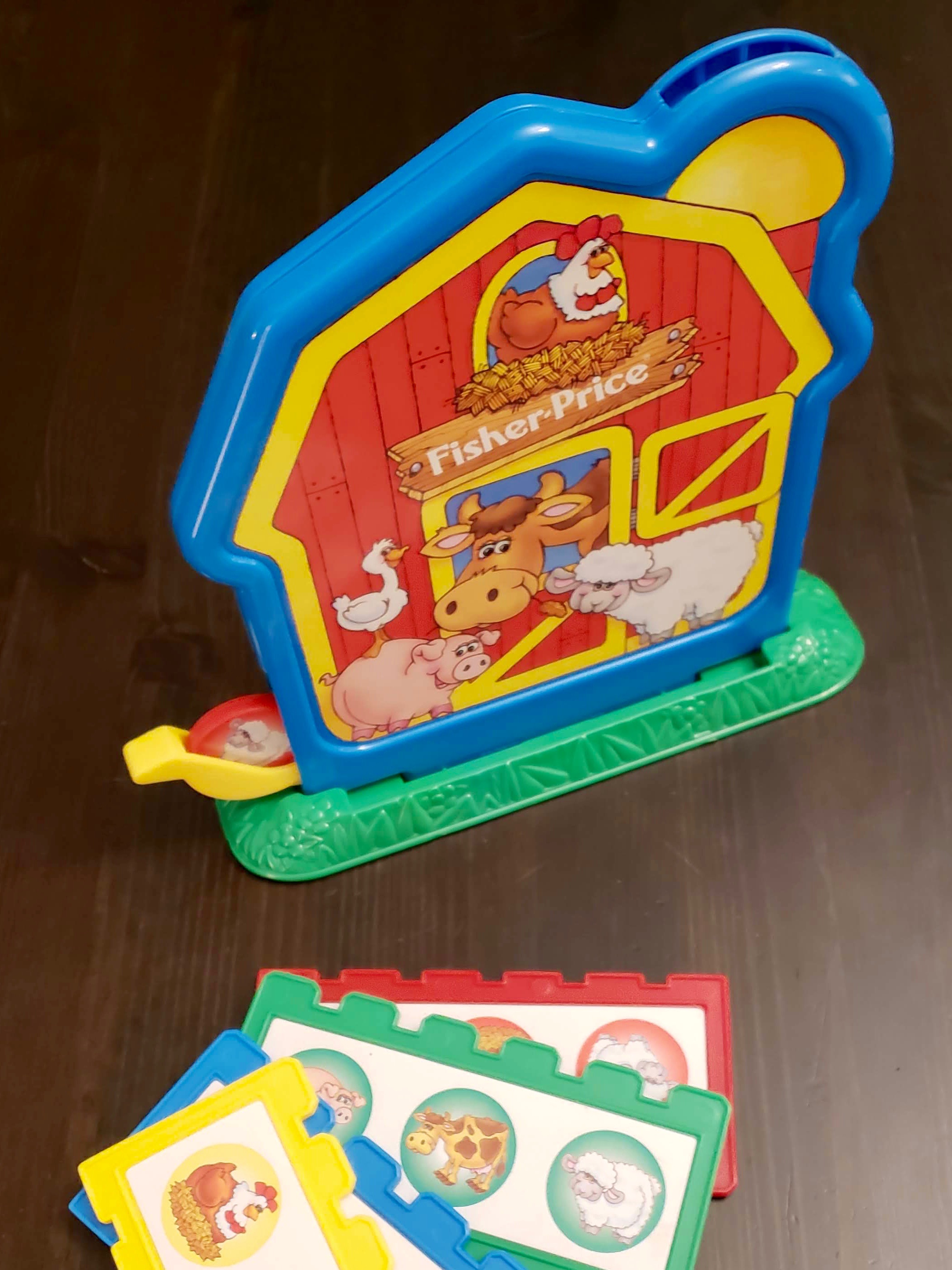
Updated on September 21, 2018
Barnyard Bingo
Barnyard Bingo is one of the first games I bought when I started out working with kids with special needs. It has stayed with me all of these years and not only continues to be a hit with kids, but the game itself is still in great shape. Barnyard Bingo contains a barn, 12 animal tokens, and 4 fence cards. A lever releases the animal tokens from the barn while making a catchy “boing” sound. I love the quality of this game. I am comfortable lending it out to families knowing it will come back in the same condition I leave it in. I love the simplicity – opening the lever releases an animal that can be matched by animal and colour to the fence cards. It is simple enough that it can be used as a first game for little ones. Kids love the sound (“Boing!”) the lever makes when it opens! Putting the animals back into the barn when we’re finished is also a lot of fun.
Disclaimer: Fisher Price has redesigned this game since I bought my original and I have not tried the new design.
Speech Activities
If you’re looking for a simple game to go along with speech practice, this is it. Before taking a turn, have your child practice a word or sound. You can use words related to the game (see below) or any words your child is working on. See speech chart for target words.
Language Activities:
Vocabulary
- Basic vocabulary – farm animals (cow, sheep, pig, chicken), animal noises, colours
- Describing – talk about the animals. What they look like, feel like, sound like, where they live, what they eat, how they move. You can also focus on colours – first learning them (the tokens are cards are red, blue, yellow, green), then thinking about other things that are the same colour (“The sky is blue too!”)
- Categories – talk about farm animals while you are playing. Think about other kinds of animals – zoo animals, water animals, bugs, etc. Talk about different names for each farm animal (male/female/young) – e.g., Horse – Stallion/Mare/Foal, Sheep – Ram/Ewe/Lamb, Goose – Gander/Goose/Gosling, Duck – Drake/Duck/Duckling, Cattle – Bull/Cow/Calf, Chicken – Rooster/Hen/Chick
- Comparing and contrasting – compare the animals. Which one is the tallest? Which one is the loudest? Which one is your favourite? How many have wings? How many have legs? Two legs? Four legs?
- Fancy words – expand your child’s vocabulary using fancy words: agriculture, coop, cattle, dairy, ewe, graze, pasture, shears.
Grammar
- Prepositions –
- Talk about where the animals are. Put them in the barn, take them out of the barn, put them on your fence card.
- Play a hiding game – hide the tokens around the room (in, on, under, behind, in front, etc.) and talk about where you found them.
- Use the farm animal bingo cards to work on beside, above, below, close to, etc. while locating the animals on your card (e.g., the foal is above the duckling).
- Plurals – count the number of animals you’ve found (2 pigs, 1 chicken, 3 sheep)
- Pronouns – this is a nice game to work on “I” sentences. Talk about what you found “I found a sheep.” and what you are doing “I’m putting the cow in the barn.”
- Irregular Past Tense Verbs – I like using Barnyard Bingo to work on the irregular past tense “found”. You can get lots of repetition if you talk about what you found each time you take an animal out. You can do the same with “got”.
Early Literacy Activities:
- Look at the letters in “Barnyard Bingo” on the barn. Notice that “barnyard” and “bingo” both start with B.
- Rhyming – sing Willoughby Wallaby using the animal names. Willoughby Wallaby weep, an elephant sat on a…..sheep! You can use the farm animal bingo calling cards as visuals for this.
- Listen and find a sound like the sounds the animals start with. Sheep starts with shhhhh just like shoe. Sh—eep, Sh—oe! Cow starts with k-k-k. What else starts with k-k-k?
- Play “guess my animal” – after taking an animal out of the barn, tell the other players the first sound of your animal and have them guess what you got. My animals starts with k-k-k. (cow) My animal starts with sh—-. (sheep)
- Story-telling – create a story about the animals.
Printables:
Speech Chart
Picture Cards
Bingo Card 1
Bingo Card 2
Bingo Card 3
Bingo Card 4
Bingo Card 5
Where to buy:
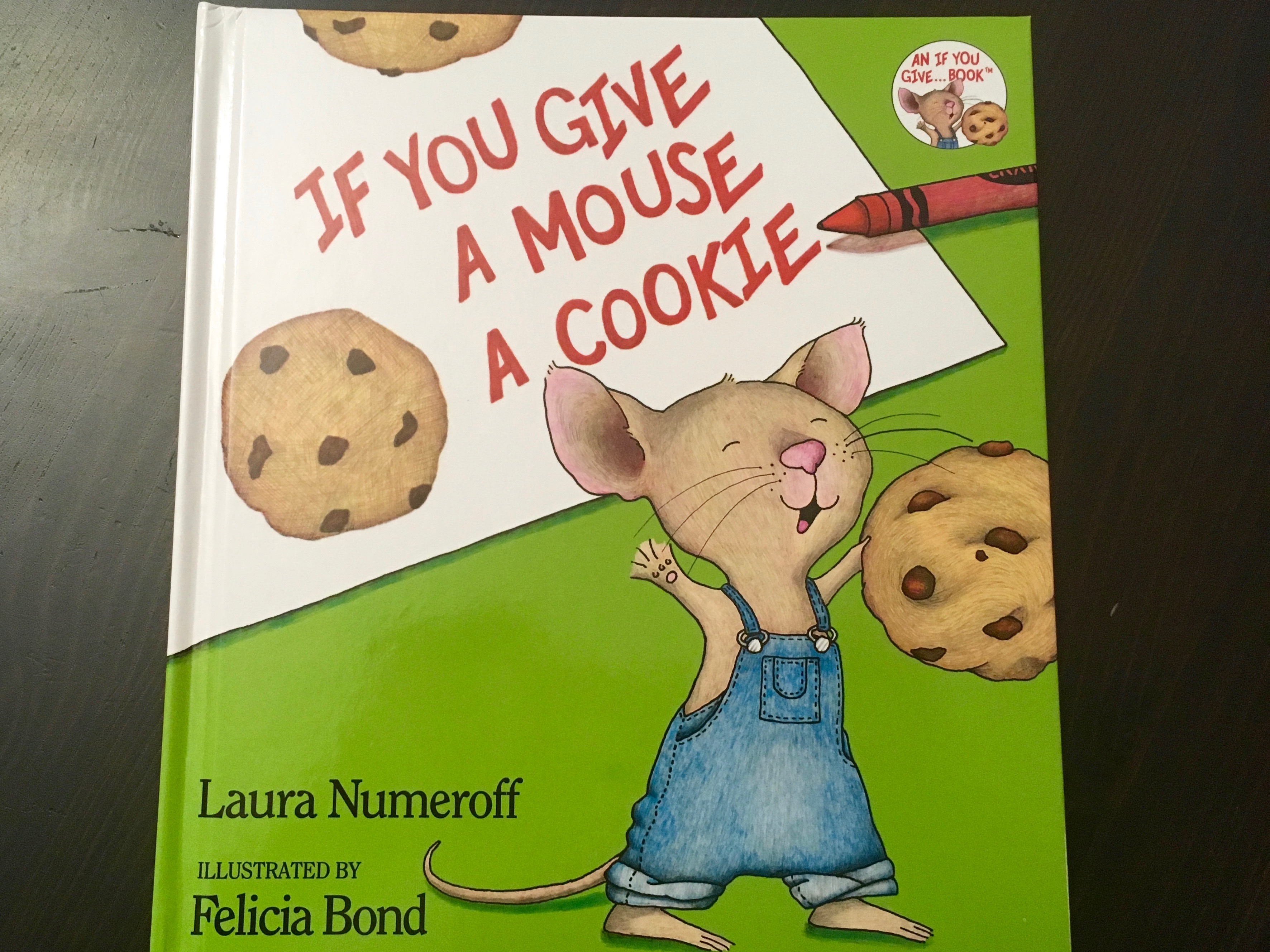
Updated on September 21, 2018
If You Give a Mouse a Cookie
If You Give a Mouse a Cookie by Laura Numeroff is such a fun book and it so easily lends itself so well to building speech, language, and early literacy skills. While the story and illustrations are a lot of fun, what I like best about If You Give a Mouse a Cookie is how easily I can change the focus for each child based on their age/developmental level as well as the skills needing to be targeted. Kids love when we add manipulatives so they can take part in telling or retelling the story.
Speech Activities:
If You Give a Mouse a Cookie can be used to target speech sounds in especially at the word level, phrase level, and in conversation.
- Use the word chart for words to practice based on sound.
- If You Give a Mouse a Cookie game board:
- /k/ – cookie, milk
- /m/ – milk
- Story round:
- Start with an “If you give a _____” sentence (e.g., If you give a fish a worm, then he will want a toothbrush.) and then take turns building on it (e.g., “If you give a fish a toothbrush, then he will want some toothpaste.”).
- **this can easily target final /f/ (if) or initial /g/ (give). You could add an alternative target sound by choosing a specific character (e.g., fish, dog, cat, rabbit, boy, girl, gorilla, etc.).
- Retelling the story:
- For kids working on generalizing their sounds, have them retell the story using story props (additional printable story props for this story are available at kizclub.com) while thinking about their target sound.
Language Activities:
Vocabulary
- Concepts –
- the story uses the following sequencing concepts: if, then, and when
- use the story props to retell the story, and focus on using sequencing concepts (first, then, next, when, after, last, etc.)
- Comparing and contrasting – figure out how the items the mouse wants go together
Grammar
- Plurals – use this If You Give a Mouse a Cookie game board to collect 1 cookie, 2 cookies, or 3 cookies. (Here are the directions.)
- Pronouns – this story uses “he” (mouse in the story is a male) and “you” frequently.
- Prepositions – this story uses “in” and “on”. Play Simon Says with the story props to incorporate prepositions (see following directions section below).
- Verbs – lots of repetition of third person singular verbs, modal verbs (might)
Following Directions
- Play Simon Says using the story props (Simon Says put the mouse under the table. Simon Says put the broom behind the door.)
- Use the game board (here are the directions) to practice if…then directions
Early Literacy Activities:
- Inferencing – lots of opportunity to ask thought questions. What do you think might happen if he gives him the cookie? Why do you think he wanted the napkin? What would you do if…? I wonder why the boy looks so tired.
- Story telling –
- Use the story props to help tell and retell the story.
- Try creating your own version of this story together – do a story round where everyone gets a turn to add an idea.
Printables:
Word chart
Game board and Directions
Story props
Where to buy:
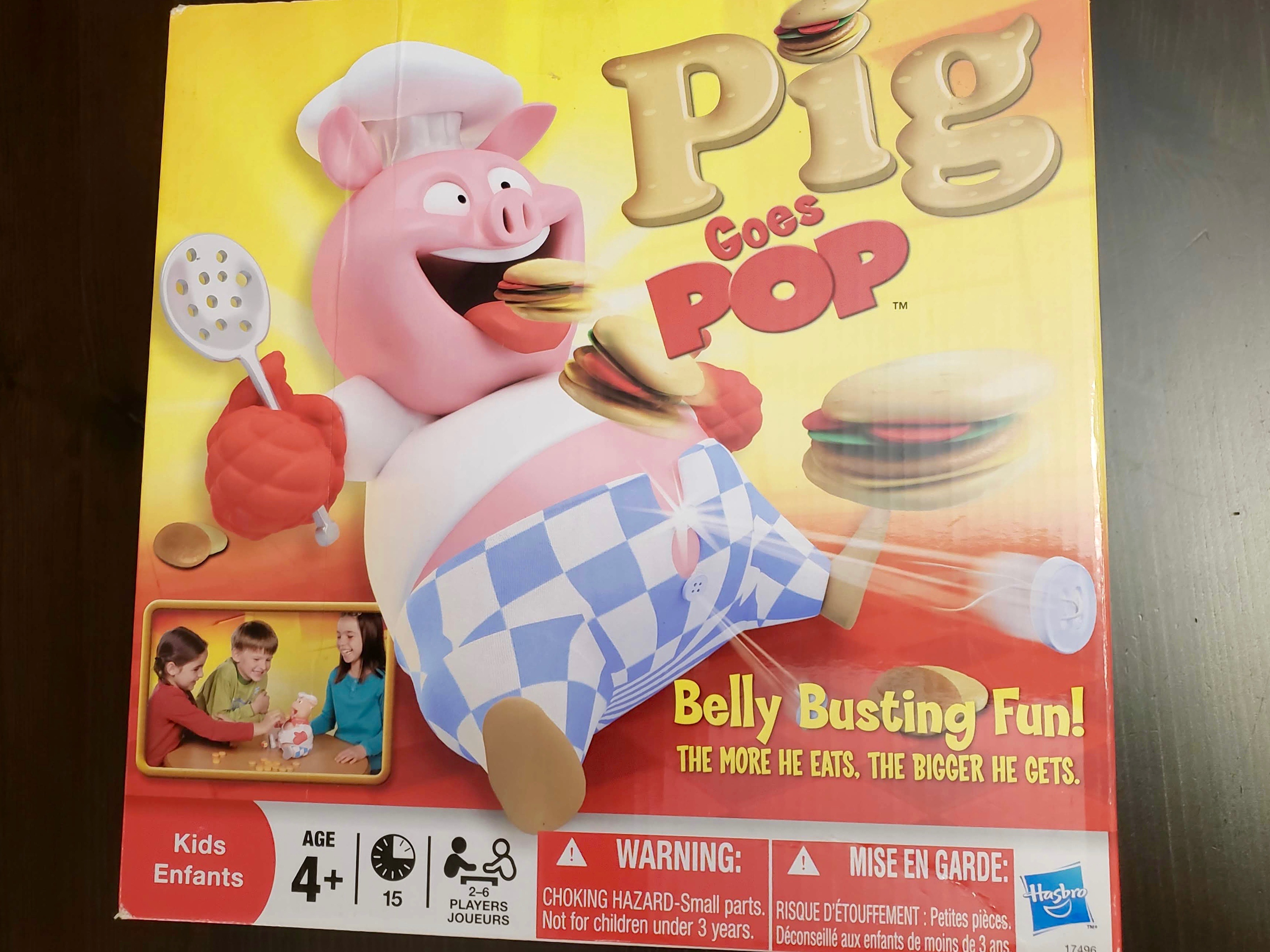
Updated on September 21, 2018
Pop the Pig
Pop the Pig (Pop Goes Pop) is a game I added to my collection a number of years ago. It has been popular since day one. The object is to feed the pig until he “pops”! One of my favourite things about Pop the Pig is that it’s a simple turn-taking game. It’s not quite as basic as a Pop Up Pirate or Barnyard Bingo, but falls into the easy to play, quick-turn category. I like games with quick turns when I want to focus on getting lots of speech practice in. I also love that I can use the many pieces (hamburgers) to expand play, for example, hiding the pieces around the room to work on prepositions. From getting to feed the pig (putting the burgers in the pig’s mouth) to pushing his head, to the anticipation that comes with waiting for the pig to pop, kids love just about everything about Pop the Pig.
Speech Activities:
Pop the Pig is a toy that can easily be played while practicing speech sounds.
- Use the word chart to find related practice words.
- Use the number on the bottom of the hamburger to tell how many times to practice a target word.
- Cover target words with the hamburgers. Practice each word as the burger is chosen.
Language Activities:
Vocabulary
- Concepts –
- Colours – Pop the Pig provides lots of repetition to help your child learn colours. Shaking the dice tells you which colour burger to choose – red, green, yellow, or purple.
- Numbers – The numbers 1-4 are also built into this game. Each burger has a number on the bottom that tells you how many times you can push the pig’s head after you feed him.
- Categories – think of items that fall into the colour categories (the number on the bottom of the burger can tell you how many words to think of). Rather than shaking the dice, give a word that matches one of the colours (e.g., sun = yellow).
- Comparing and contrasting – use comparatives and superlatives (big/bigger/biggest, hungry/hungrier/hungriest).
- Fancy words – expand your child’s vocabulary using fancy words:
- disappointed – “You look disappointed you didn’t get to make the pig pop.”
- enormous – “The pig’s belly is growing…it’s enormous!”
- feast – “This pig has 12 burgers to feast on!”
- gigantic – “His belly is gigantic!”
- nervous – “I’m feeling nervous that the pig is going to pop!”
- suddenly – “Suddenly I’m feeling very nervous!”
- surprise – “That surprised me! I didn’t think he was going to pop.”
- wonder – “I wonder how many more burgers he needs before he will pop.”
- worry – “Don’t worry you didn’t get to make him pop. We can play again later.”
Grammar
- Question formation – “What colour did you get?” and “What number did you get?” can be repeated throughout this game.
- Plurals – Count how many burgers are left – 5 burgers? 2 red burgers? 3 purple burgers?
- Pronouns – give the pig a name (it could be either a boy or girl) and then talk about it using he or she.
- Prepositions – Before playing, set the burgers up around the room. Each colour could go in a different location (on the table, under the chair, between 2 players).
Following Directions
- If if your child has a tricky time understanding directions, try pairing visuals with the auditory directions. For example show “purple” and “in” when your child has to put in the the purple burger.
- Have your child teach you how to play, giving step-by-step directions (shake the dice, look at the colour, pick a ____ burger, check the number on the bottom of the burger, put the burger in the pig’s mouth, push the pig’s head ____ times).
Early Literacy Activities:
- Phonological awareness –
- Rather than using the dice, give the first sound of the colour (e.g., /r/ = red, ‘y’ = yellow, /p/ = purple, /g/ = green)
- Sing Willoughby Wallaby using the colour names (“Willoughby Wallaby wed, an elephant sat on….” red “Willoughby Wallaby wurple, an elephant sat on…” purple)
- Story telling –
- Tell a group story about the pig. Each person gets to add an idea.
Printables:</p/>
Picture Cards
Where to buy:
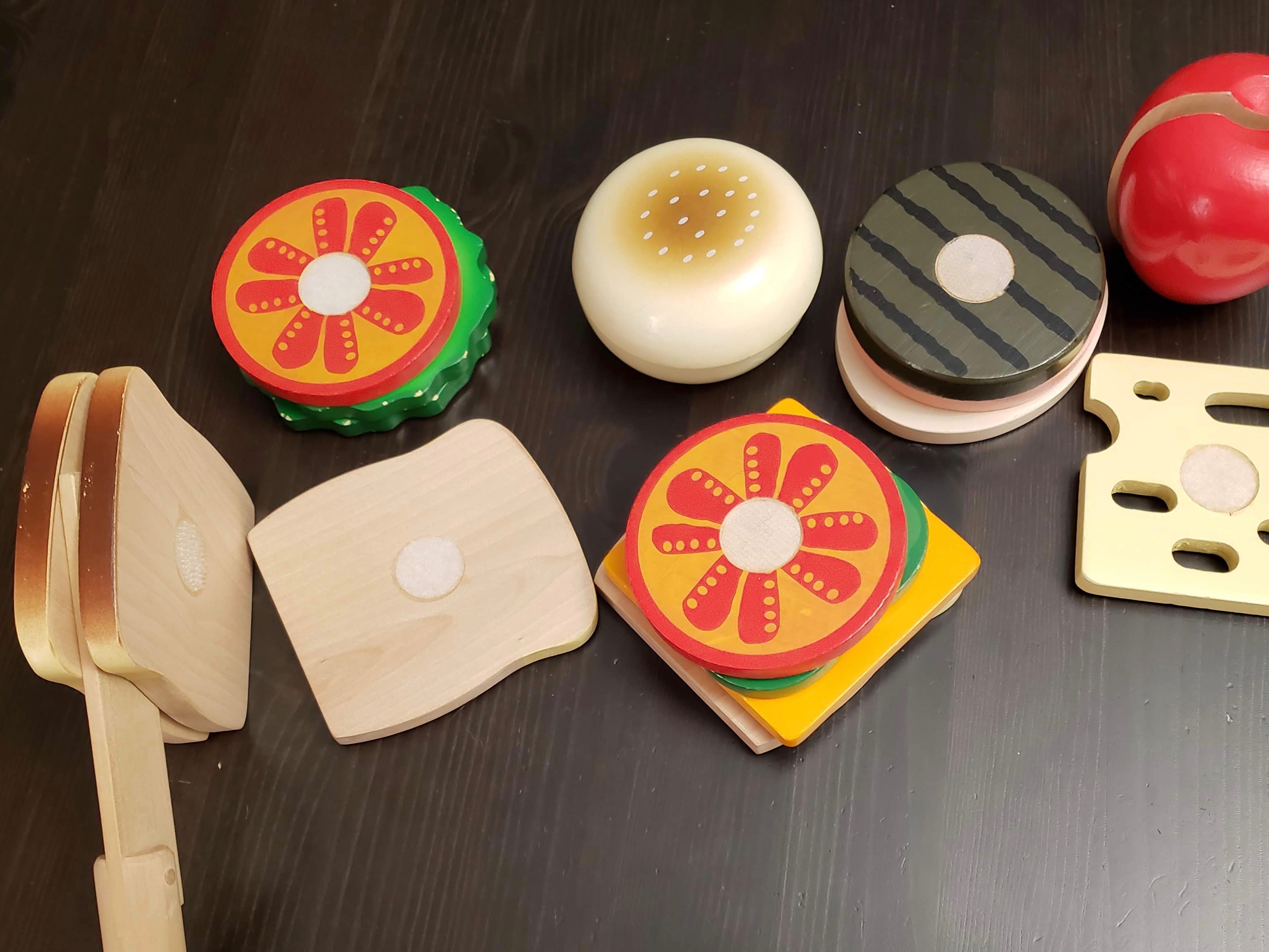
Updated on September 21, 2018
Melissa and Doug Wooden Sandwich Making Set
I bought the Melissa and Doug Wooden Sandwich Making Set years ago and continue to use it today. This toy contains wooden food pieces for making sandwiches and hamburgers. The food pieces stick together with velcro and can be cut apart with the wooden knife. I have come to expect quality from Melissa and Doug products and this Wooden Sandwich Making Set does not disappoint. The wooden pieces are so sturdy and durable that I know it will last for years to come. I really love how easy it is to expand the play beyond building sandwiches. You can get as creative as you want…make a restaurant, grocery store, or even play hiding games with the pieces. Making and pretending to eat sandwiches is fun for kids and the colourful food pieces are enticing. But the best part? The crunching sound the velcro makes as the knife cuts the food apart!
Speech Activities:
Melissa and Doug Wooden Sandwich Making Set is a wonderful toy to use to help your child with his or her speech sounds. While this toy lends itself to working on the carryover of sounds into conversation, you can also use it when your child is just learning a new sound.
If your child is just learning a new sound, try using it to make sound effects! Here are some ideas but feel free to get creative and make up your own:
- /k/ could be the sound of the knife cutting “k-k-k-k-k-k”
- /s/ could be the sound of sauce squirting onto the sandwich or the cheese melting if you make a grilled cheese sandwich “ssssss”
- /z/ could be the sound of the burger sizzling on the grill “zzzzzzz”
- /f/ could be the sound you make when your food is too hot and you need to cool it off “ffffffff”
- ‘sh’ could be the sound you make when shaking salt and pepper “sh-sh-sh-sh”
Use the word chart to find words you can practice while making sandwiches or playing restaurant.
Initial /f/:
- Make a grilled cheese sandwich or cook the burger in the frying pan.
- Play “Find It” using these sandwich picture cards. Take turns hiding pictures around a room and telling which picture to find (“Find the swiss cheese.”). When you find it, tell where you found it (“I found it under the table.”).
- Play Go Fish using these sandwich picture cards. Focus on “Go fish”.
- Play Memory using these sandwich picture cards – talk about the pictures that you find (“I found a sandwich and a pickle.” “I found a match.”)
Initial /s/: play Go Fish or Memory using these /s/ sandwich picture cards. Remember to practice saying “same” when you find a match!
Initial /k/: play Go Fish or Memory using these /k/ sandwich picture cards.
Langauge Activities:
Vocabulary
- Describing – talk about what each of the sandwich ingredients tastes like, looks like, sounds like, feels like. Think about shape, size, texture, temperature.
- Categories – talk about food groups while you are playing. Cheese is a dairy product, just like milk; cucumbers and tomatoes are vegetables; ham, burgers, and turkey are meats. Think about other categories you can talk about: things that are red like the tomatoes or green like the lettuce and cucumbers.
- Comparing and contrasting – decide which topping is your favourite and talk about why. Use -er and -est endings to help you compare, like juicy/juicier/juiciest (“The tomatoes are the juiciest!”), crunchy/crunchier/crunchiest (“The lettuce is crunchier than the tomatoes but the pickles are the crunchiest!”), big/bigger/biggest (“My sandwich is big, but yours is bigger!”)
- Fancy words – expand your child’s vocabulary using fancy words: decide (There are so many options, how will I decide what to order?), enormous (This sandwich is the biggest I’ve ever seen, it’s enormous!), feast (Our food is ready, let’s feast!), gigantic (Your sandwich looks like its going to fall over, it’s gigantic!), huge (Your sandwich is huge, it’s almost as big as an elephant!), ingredients (If we’re going to make a submarine sandwich, we’re going to need more ingredients.), prefer (I would prefer swiss cheese instead of cheddar.), protect (I don’t want to spill anything on my shirt so I will protect it with a napkin.).
Grammar
- Question formation – this toy feels like it was made for kids to practice asking questions! Set up a restaurant and you can get lots of practice asking your customers what they would like on their sandwich. Are you ready to order? Would you like bread or a bun? What kind of cheese would you like? Cheddar or swiss? Would you like lettuce? How many slices of tomatoes would you like?
- Plurals – I would like two sandwiches please. Two slices of tomato.
- Pronouns – set up a restaurant and your server can tell the chef what the customers would like. She would like a grilled cheese sandwich. He would like a burger with tomatoes.
- Prepositions – Try playing a game of “Find it!” Take turns hiding the food, talking about where you find it. You can also give clues where to look (The bun is hiding under/behind/inside…). When making burgers think about where you are putting the food. Will the sauce go on your sandwich or beside? Will the pickles go on the bottom?
Early Literacy Activities:
- Write a menu for your restaurant – listen to the sounds in the words as you write them down (t-t-t-tomato, b-b-b-burgerrrrrr). Your child can draw pictures or even write some of the letters if he/she knows how. Here is a blank menu for you to add to. Or try this menu that has food items already added.
- Write down orders – as the customer is order, write down what they would like. Pretend writing is okay!
- Grocery list – pretend you need to go shopping for ingredients. Think about what you will need to buy and write it down – remember to think about the sounds as you write it down (c-c-c-cabbage, sssssss-auce).
Printables:
Picture Cards
Initial /s/ Picture Cards
Initial /k/ Picture Cards
Menu
Menu – Blank
Where to buy:
